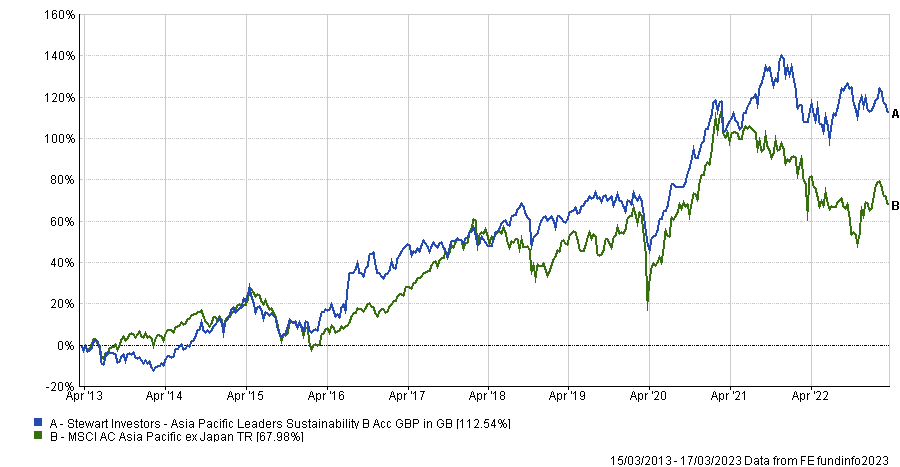Younger investors tend to have more exposure to US funds as they look to benefit from the dominant technology companies and growth stocks in this region, data from Hargreaves Lansdown has revealed.
For instance, there were three funds in the IA North America sector among the top 10 picks of those aged 18-29: Baillie Gifford American, Legal & General US Index and UBS S&P 500 Index.
Investors aged 30-54 showed less interest in a specific exposure to the US market than their younger peers, removing UBS S&P 500 Index from their list.
Older age brackets deemed one US fund – Legal & General US Index – to be a sufficient exposure to the IA North America sector, while investors aged 81 or more do not have any US exposure among their favourite funds.

Source: Hargreaves Lansdown
Income funds’ popularity increases with the age of the investors, as they approach or already are in retirement. People aged 55-64 and 65-80 had two income funds in their top 10 list, while the oldest cohort had six. Artemis Income and BNY Mellon Global Income were the two income funds most commonly held across the different age groups.
Global funds were not as popular either with older investors, with only two such funds in their top 10. All the other age brackets had four global funds in their list.
However, the only two funds that all age categories were holding are in the global sector: Fundsmith Equity and Lindsell Train Global Equity.
Fundsmith Equity has been one of the best performers in the IA Global sector over 10 years, returning 296.3%. It is above the sector average of 131.9%.
It has been among the sector’s top quartile for every period, except on a three-year basis where the fund falls into the second quartile, returning 52.3%, just below the sector average of 53.3%.
Total return of fund vs benchmark and sector over one year

Source: FE Analytics
Terry Smith’s fund, which is one of the largest in the Investment Association universe, had a difficult 2022, underperforming both the sector and the MSCI World index but has had a strong start this year being top quartile over 12 months.
The manager invests with a low-turnover approach, choosing companies with strong balance sheets that can grow at a reasonable rate and have structural benefits such as barriers to entry or a rapidly rising sector. This approach is known as quality growth.
Last year he told investors that this had led to being overweight technology, but that the fund was not turning into a specialist portfolio.
The other global fund to appear in all age brackets is Lindsell Train Global Equity, managed by Nick Train. It is another example of a fund that outperformed the IA Global sector over 10 years, although with a smaller margin than Fundsmith Equity. It returned 224.7% over that period.
It also was one of the worst fund in the IA global sector over three years, returning 32.5%, while the sector average was 53.3%.
Total return of fund vs benchmark and sector in 2023

Source: FE Analytics
The fund is invested with the same school of thought as the Fundsmith portfolio, but holdings differ. Indeed, Lindsell Train Global Equity’s largest holdings are Diageo, FICO, Heineken Holding, London Stock Exchange Group and Mondelez.
Earlier this year Train lamented the performance of some of his stocks, but the portfolio has bounced back in recent months as its underweight to banks and financials has held it in good stead during the current environment.
While not a favourite among all of the age ranges, honourable mention also goes to Stewart Investors Asia Pacific Leaders Sustainability, which was in the top 10 for those in the 30-54, 55-64 and 65-80 age brackets.
The fund aims to achieve capital growth by investing in large and mid-sized companies in the Asia Pacific region (excluding Japan) that are positioned to benefit from, and contribute, to sustainable development.
It has returned 112.54% over 10 years, which is almost twice the performance of its benchmark. It also outperformed the MSCI Asia Pacific ex Japan index over five years and three years, but has underperformed it over one year and six months.
Total return of fund vs benchmark over 10yrs

Source: FE Analytics
Individual shares in common
The same patterns between the different age groups apply for shares, with young people having a bias for technology companies.
Amazon, Apple, Microsoft Corporation and Tesla are among the 10 most popular stocks of those aged 18-54.
In comparison, older investors see the potential in pharmaceuticals, with AstraZeneca and GlaxoSmithKline among their top holdings.
%20by%20age%20group1.png)
Source: Hargreaves Lansdown
Emma Wall, head of investment analysis and research at Hargreaves Lansdown, said: “Older and younger investors have some striking differences when it comes to their portfolios, but an awful lot of it is driven by them tailoring their investments to their stage in life. When it comes to their overall approach, they have more that unites than divides them.
“However, different generations of investors are seeing opportunity in different places. Younger people are more likely to have technology companies in the mix, taking advantage of the way tech is transforming economies around the world. Meanwhile, older investors see the potential in pharmaceuticals as the population ages.”
Investors aged 55 or more also had a home-bias, with their 10 top holding all being UK companies, while four of younger investors’ picks came from overseas.





